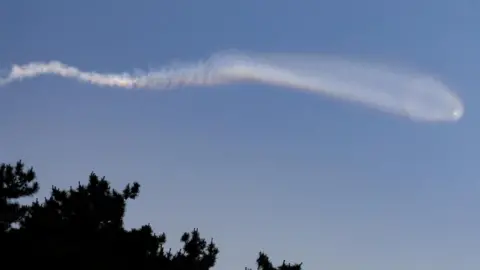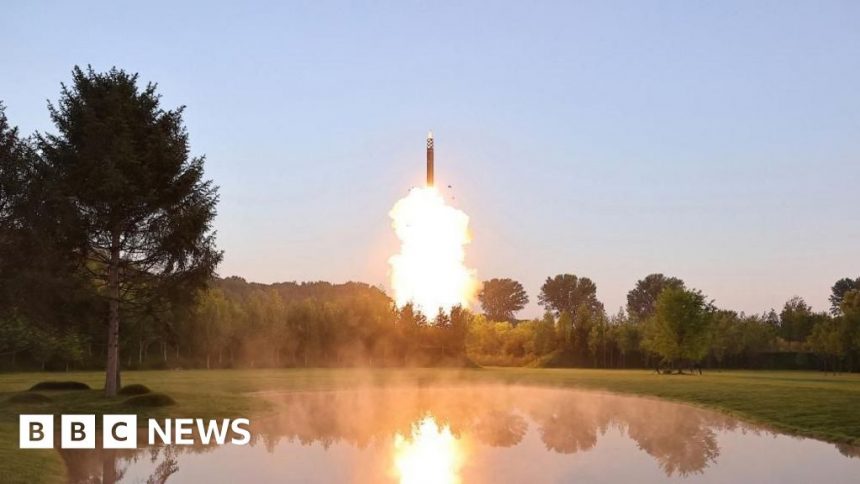North Korea says it fired a new weapon – is it lying?
 Reuters
ReutersA weapons test this week has become the latest point of contention between North and South Korea, with Pyongyang saying they fired an advanced multiple warhead missile and Seoul accusing them of lying.
Hours after North Korean state media lauded the “success” of their test and ran pictures as proof on Thursday, the South called it “deception and exaggeration” and released their own evidence pointing towards failure.
Analysts meanwhile remain uncertain about the truth of the North’s claims.
The dispute underscores the complexities of verifying North Korea’s weapons development, which continues to advance despite severe international sanctions.
If North Korea’s latest claims are true, it would represent significant progress in their missile programme.
Multiple warhead missiles are difficult to defend against and the technology is challenging to develop. Currently only the US – which first developed it in the 1960s – as well as the UK, France, Russia and China are known to have these capabilities.
Pyongyang is now trumpeting that they are a step closer to achieving it as well.
For some time now, experts have floated the possibility of North Korea eventually developing MIRV capabilities.
MIRV stands for multiple independently targetable re-entry vehicle. The technology involves attaching several warheads to a single missile that would separate after launch. The warheads would then be powered by their own rockets to hit various targets.
They can be released at different speeds and in multiple directions, allowing them to hit targets hundreds of kilometres apart from one another. This is what makes these weapons particularly efficient.
Pyongyang said on Thursday that it had “successfully conducted the separation and guidance control test of individual mobile warheads” the day before. The weapon, it said, used the first-stage engine of an intermediate-range solid-fuel ballistic missile, and deployed three warheads plus a decoy.
The missile travelled a “shortened range” of 170 to 200km (105 to 124 miles) to ensure safety and measure the flights of the warheads, said state media. The warheads were each “guided correctly” to their targets while anti-air radar found the decoy had effectively deployed as well.
The test was of “great significance in bolstering” their missile forces and was aimed at “securing the MIRV capability”, which has been set as a top priority.
 Reuters
ReutersSouth Korea’s military however was quick to debunk these claims, saying the “flight was not normal” and that the weapon had exploded mid-flight.
It released a video it had filmed of the test, saying that the initial stage showed an unstable flight that led to a mid-air explosion. Military officials said they detected a large amount of debris, more than what should result from a successful test.
They also said North Korea’s pictures purportedly showing the warheads and decoy separating from the missile were actually pictures of an intercontinental ballistic missile test carried out in March.
Analysts cited by South Korean news agency Yonhap pointed out that the range of the test was more typically seen in intercontinental ballistic missile tests. They also believed the missile may have had insufficient guidance and control systems.
Other experts believe some parts of the test succeeded – though much remains unknown.
Yang Uk, a researcher at Asan Institute for Policy Studies, told the BBC that while he believed the flight and separation of warheads had worked, “North Korea has not revealed evidence whether the warheads reached their targets – we cannot say they succeeded here”.
Japan’s defence ministry said the missile achieved a maximum altitude of 100km. This meant it did not enter outer space and instead stayed in the Earth’s atmosphere. Dr Yang said this also meant that “the warheads were not tested for the high heat and pressure that follow re-entry into atmosphere, so we cannot know their capabilities”.
The weapons test was spotted by South Koreans living by the border, and a video carried by South Korean media taken by a civilian observer showed a visible contrail in the sky.
 Reuters
ReutersNorth Korean weapons expert and former US State Department official Vann Van Diepen said the video “does not seem to indicate a big explosion or catastrophic failure”, and the contrail appeared consistent with North Korean state media photos.
“But that does not rule out a more subtle failure,” he added, noting that there was no independent proof that warheads were released and successfully flew on their own.
Whatever the truth of the test’s success, what is clearer is that North Korea would still have reaped some gains.
Observers point out that Pyongyang would have obtained useful technical data from the launch, putting them one step closer to achieving MIRV capability, a goal publicly set by North Korea’s government in 2021.
MIRV missiles would be prized given their “productivity”, said Mr Van Diepen, particularly in a situation where North Korea may have a depleted missile arsenal following a first strike from an enemy.
This week’s test, even if successful, would not be enough to complete the development of such a weapon, but he estimated the North Koreans were “at least a few years away” from that goal.
The timing of the test – days before an expected plenary meeting where North Korean officials will gather to review their work in the first half of the year – may not be coincidental. It could be aimed at showcasing the military’s achievements, say other experts.
It would also have sent a message of continued defiance and a signal of the country’s developing capabilities to its enemies.
Washington has said little in response to the latest test, apart from releasing a short joint statement with Japan and South Korea condemning it. But Mr Van Diepen said the US government, which would have the best resources to analyse North Korea’s weapons tests, could and should shed more light.
“Otherwise, the North gets a free propaganda win.”
Additional reporting by Jake Kwon and Rachel Lee







